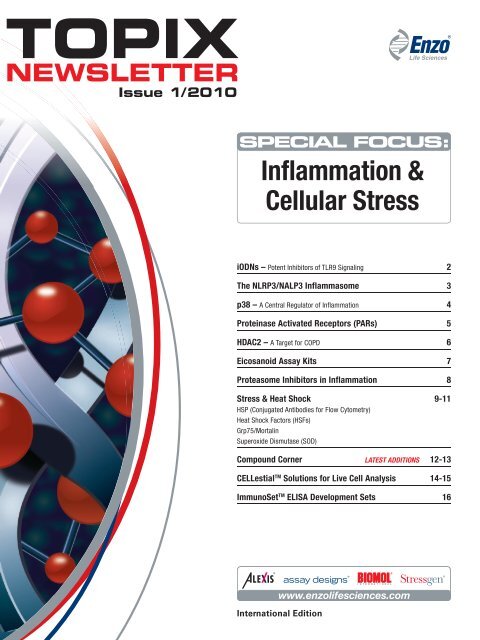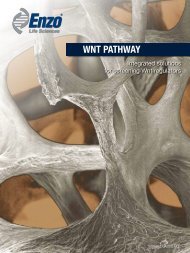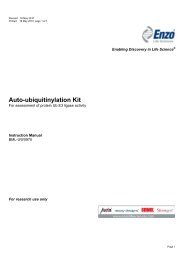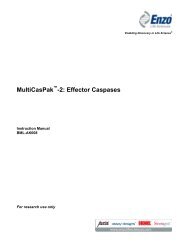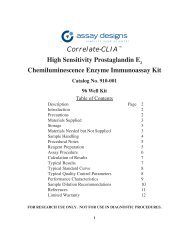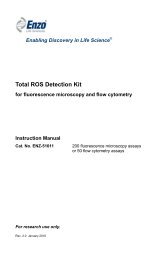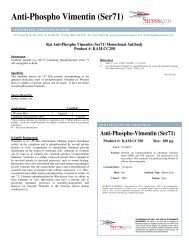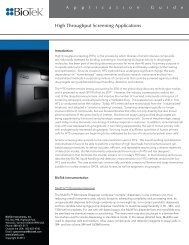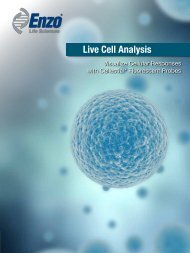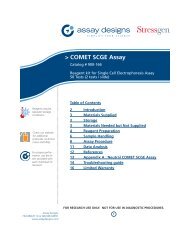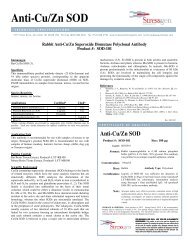Download as PDF - Enzo Life Sciences
Download as PDF - Enzo Life Sciences
Download as PDF - Enzo Life Sciences
You also want an ePaper? Increase the reach of your titles
YUMPU automatically turns print PDFs into web optimized ePapers that Google loves.
TOPIXNEWSLETTERIssue 1/2010Inflammation &Cellular StressiODNs – Potent Inhibitors of TLR9 Signaling 2The NLRP3/NALP3 Inflamm<strong>as</strong>ome 3p38 – A Central Regulator of Inflammation 4Protein<strong>as</strong>e Activated Receptors (PARs) 5HDAC2 – A Target for COPD 6Eicosanoid Assay Kits 7Prote<strong>as</strong>ome Inhibitors in Inflammation 8Stress & Heat Shock 9-11HSP (Conjugated Antibodies for Flow Cytometry)Heat Shock Factors (HSFs)Grp75/MortalinSuperoxide Dismut<strong>as</strong>e (SOD)Compound Corner LATEST ADDITIONS 12-13CELLestial TM Solutions for Live Cell Analysis 14-15ImmunoSet TM ELISA Development Sets 16www.enzolifesciences.comInternational Edition
iODNs – Potent Inhibitors of TLR9 SignalingToll-like receptor 9 (TLR9) recognizes unmethylated CpG motifs in viral and bacterial DNA. Signaling through TLR9 can be accomplishedwith high effi ciency with small, synthetic oligodeoxynucleotides (ODNs) containing optimized CpG motifs, whichshow great promise <strong>as</strong> potent vaccine adjuvants and inhibitors of Th2-mediated allergic responses.In contr<strong>as</strong>t, inhibitory oligodeoxynucleotides (iODNs) composed of TTAGGG multimers are capable of depressing TLR9 signaling.Several groups have studied the sequence requirements, specifi city, signaling pathways and kinetics of the TLR (Toll-likereceptor) 9 suppression by ‘inhibitory DNA motifs’, which led to a novel cl<strong>as</strong>sifi cation of iODNs, that is independent of thepreviously thought species preference.2Cl<strong>as</strong>s I:Cl<strong>as</strong>s II:G-stretch ODNs: TLR9-specifi c competitors, some iODNs may also affect TLR7 and TLR8 signalingODNs with telomeric repeats: TLR-independent inhibitors of STAT signalingiodns - Potent inhibitors of tlr9 signAlingCl<strong>as</strong>s III:Cl<strong>as</strong>s IV:Inhibitors of DNA uptake in a sequence independent mannerLong phosphorothioate ODNs <strong>as</strong> direct competitors of TLR9 signaling in a sequence independent mannerLIT: Immunotherapeutic utility of stimulatory and suppressive oligodeoxynucleotides: K.J. Ishii, et al.; Curr. Opin. Mol. Ther. 6, 166 (2004) • Inhibitory oligodeoxynucleotides - therapeutic promise forsystemic autoimmune dise<strong>as</strong>es?: P. Lenert; Clin. Exp. Immunol. 140, 1 (2005) • DNA motifs suppressing TLR9 responses: A. Trieu; Crit. Rev. Immunol. 26, 527 (2006)Inhibitory ODNs (iODNs)Product/Sequence Prod. No. SizeiODN 2088 (cl<strong>as</strong>s I) (endotoxin-free) (synthetic)5’-tcctggcggggaagt-3’iODN (ttaggg) 4(cl<strong>as</strong>s II) (endotoxin-free) (synthetic)5’-tttagggttagggttagggttaggg-3’G-type-iODN (cl<strong>as</strong>s I) (endotoxin-free) (synthetic)5’-ctcctattggggtttcctat-3’Core-iODN (cl<strong>as</strong>s I) (endotoxin-free) (synthetic)5’-tcctggagggg-3’Super-iODN (cl<strong>as</strong>s I/II hybrid) (endotoxin-free) (synthetic)5’-cctcaatagggtgagggg-3’Dual-iODN (cl<strong>as</strong>s I) (endotoxin-free) (synthetic)5‘-tgctcctggaggggttgt-3‘Control CompoundsNeutral-ODN (Control for iODNs) (endotoxin-free) (synthetic)5‘-tcctgcaggttaagt-3‘IntroductionKEy TLR LIGANDSAND THEIR RECEPTORSIn 1996 the To l protein in Drosophila w<strong>as</strong> discovered to be important for defense against microbial infection [1]. One year latera human homolog, now known <strong>as</strong> To l-like receptor 4 (TLR4), h<strong>as</strong> been identifi ed through datab<strong>as</strong>e searches [2]. To date, 13mouse and 10 human TLRs have been identifi ed. TLRs induce signaling pathways which result in a variety of celula responsesthat include the production of interferons (IFNs) and various cytokines, such <strong>as</strong> tumor necrosis factor (TNF)-α, interleukin (IL)-6and IL-12. The cytopl<strong>as</strong>mic region of TLRs consists of a To l/IL-1 receptor (TIR) domain, showing high similarity to that of the IL-1receptor family. The extracelularegion mainly consists of leucine-rich repeats (LRRs) which are important for the recognition ofPAMPs.TLR LigandsTLRs are expressed not only on antigen presenting cels (APCs) such <strong>as</strong> dendritic cels (DCs), macrophages and B cels, but alsoon specifi c T cels and non-immune cels (e.g. fi brobl<strong>as</strong>ts and epithelial cels). They detect PAMPs of bacteria, viral, fungal andprotozoal origin. The various TLRs can be roughly subcl<strong>as</strong>sifi ed according to the PAMPs they recognize. TLR1, TLR2 and TLR6detect lipopeptides, while TLR3, TLR7, TLR8 and TLR9 recognize nucleic acids. TLR5 detects fl agelin, while TLR4 recognizes adiverse colection of lipopolysaccharides (LPS). For a comprehensive overview of TLR ligands see pages 2–3. The extracelularregion and LRRs either directly or indirectly interact with the ligands. For instance, MD-2, CD14 and LPS-binding protein (LBP)appear to be co-receptors of TLR4, where<strong>as</strong> fl agelin and unmethylated CpG oligonucleotides appear to interact directly withTLR5 and TLR9, respectively [3-5].LIT: [1] The dorsoventral regulatory gene ca se te spatzle/Tol/cactus controls the potent antifungal response in Drosophila adults: B. Lemaitre, et al.; Cel 86, 973 (1996)•[2] A human homologue of the DrosophilaTo l protein signals activation of adaptive immunity: R. Medzhitov, et al.; Nature 3 8, 394 (1997)•[3] LPS, TLR4 and infectious dise<strong>as</strong>e diversity: S. I. Miler, et al.; Nat. Rev. Microbiol. 3, 36 (2005)•[4]Direct evidence that tol-like receptor 9 (TLR9) functionaly binds pl<strong>as</strong>mid DNA by specific cytosine-phosphate-guanine motif recognition: S. Cornelie, et al.; J. Biol. Chem. 279, 15124 (2004)•[5] To l-like receptor5 recognizes a conserved site on flagelin required for protofilament formation and bacterial motility: K. D. Smith, et al.; Nat. Immunol. 4, 1247 (2003)Toll-like Receptor SignalingFIGURe 1: Signaling Pathways of TLRs.TLR ligand binding results in TLR hetero- or homodimerizationbringing the cytopl<strong>as</strong>mic TIR domains to close proximity andsubsequently recruit adaptor molecules. Adaptors of TLRs areTIR-domain containing molecules, namely primary MyD88, Mal(TIRAP; TIR-<strong>as</strong>sociated protein; MyD88 adaptor-like protein), TRIF(TIR domain-containing adaptor protein-inducing IFN-β; TICAM-1;TIR-containing adaptor molecule-1), TRAM (TRIF-related adaptormolecule; TICAM-2; TIR-containing adaptor molecule-2) andsterile alpha and HEAT-armadi lo motifs (SARMs). The induction ofdi ferent signaling responses by the individual TLRs may be partlyexplained by the usage of di ferent adaptor molecules.Product FlyerInternational Edition 1-Nov-2009incorporatingwww.enzolifesciences.comIntroductionProduct FlyerInternational Edition 1-Nov-2009NOD-LIKE RECEPTORS (NLRs)In mammals, germ-line encoded pa tern recognition receptors (PRRs) detec the presence of pathogens either directly through recognitionof pathogen-<strong>as</strong>sociated molecular pa terns (PAMPs) or indirectly through sensing host-derived danger signals (DAMPs).The innate immune system comprises several cl<strong>as</strong>ses of PRRs that a low the early detection of pathogens a the site of infection.The membrane-bound to l-like receptors (TLRs) detect microbes on the ce l surface and in endosomes. The RIG-1 (retinoic acidinduciblegene I)-like receptors (RLRs; RLHs) and the Nod-like receptors (NLRs; nucleotide-binding domain leucine-rich repeatcontaining receptors) detect microbial components in the cytosol.NLR ProteinsThe intrace lular NLR proteins organize signaling complexes such <strong>as</strong> inflamm<strong>as</strong>omes and NOD signalosomes. These proteinshave been first identified due to their homology with the plant R proteins, a large family of proteins involved in resistance to phytopathogens.NLRs contain three characteristic domains:1) a C-terminal leucine-rich repeat (LRR) domain responsible for ligand sensing and autoregulation;2) a central NACHT (NOD) domain that h<strong>as</strong> similarity to the NB-ARC motif of the apoptotic mediator APAF1 and is required fornucleotide binding and self-oligomerization; and3) an N-terminal e fector domain responsible for signal transduction and activation of the inflammatory response. To date, fourdi ferent N-terminal domains have been identified: acidic transactivation domain, c<strong>as</strong>p<strong>as</strong>e-recruitment domain (CARD), pyrindomain (PYD), and baculoviral inhibitory repeat (BIR)-like domain.incorporatingFIGURe 1: Human NLRs and their domains.www.enzolifesciences.com(BULK)(BULK)(BULK)(BULK)(BULK)(BULK)(BULK)ALX-746-250-T050ALX-746-350-M001ALX-746-251-T050ALX-746-351-M001ALX-746-252-C100ALX-746-352-M001ALX-746-253-C100ALX-746-353-M001ALX-746-254-C100ALX-746-354-M001ALX-746-255-C100ALX-746-355-M001ALX-746-256-C100ALX-746-356-M001Key TLR Ligands and their Receptors &Nod-like Receptors• TLRgrade – LPS & Lipid A Reagents• Full Panel of CpG ODNs & iODNs• Antibodies to Toll-like Receptors• Nod-like Receptors & their Ligands• Inflamm<strong>as</strong>ome Reagents• And many more...50 tests1 mg50 tests1 mg100 µg1 mg100 µg1 mg100 µg1 mg100 µg1 mg100 µg1 mgVisit www.enzolifesciences.com for a complete listing or<strong>as</strong>k for a free copy of our new product fl yers.www.enzolifesciences.com
p38 – A Central Regulator of Inflammationp38 MAP kin<strong>as</strong>e plays important roles in many inflammatory dise<strong>as</strong>es including rheumatoid arthritis, inflammatory bowel dise<strong>as</strong>eand chronic obstructive pulmonary dise<strong>as</strong>e. It is known to regulate the production of many key inflammatory proteinssuch <strong>as</strong> COX-2, iNOS, and the proinflammatory cytokines IL-1b, TNF-a and IL-6 <strong>as</strong> well <strong>as</strong> function in downstream signaltransduction from cytokines like TNF-a. p38 inhibitors are anti-inflammatory and <strong>as</strong> orally active small molecules, might bedesirable therapeutics over the successful biological therapies for inflammatory disorders.p38 Enzymes4p38 – A central regulator of inflammationProduct Prod. No. Sizep38a (human), (rec.) BML-SE499-0020 20 µgp38g (human), (rec.)p38δ (human), (rec.)p38 AntibodiesBML-SE426-0005BML-SE426-0020BML-SE427-0005BML-SE427-0020Product Specificity Application Prod. No. SizeJNK/p38, mAb (9H8) Human, mouse IHC, IP, WB ALX-804-241-C100 100 µgp38a, mAb (20B11) Human, mouse, rat and dog WB ALX-804-183-C100 100 µgp38δ, mAb (5H7)Human, mouse (weak) and rat(weak)5 µg20 µg5 µg20 µgIHC, WB ALX-804-222-C100 100 µgp38/Mxi2, mAb (2F2) Human, mouse, rat and dog IP, WB ALX-804-394-C100 100 µgp38/Mxi2, mAb (13D5) Human, mouse, rat and dog ICC, IP, WB ALX-804-184-C100 100 µg[pThr 180 /pTyr 182 ]p38, pAbp38 InhibitorsSD-169Human, mouse, rat, dog andfishBML-EI371-0010 10 mgBML-EI371-0050 50 mgAn indole derivative that inhibits p38a (IC 50=3.2nM) and p38b (IC 50=122nM),but not p38g (IC 50>50μM), ERK2, JNK1or MAPKAP2.LIT: Preventive and therapeutic potential of p38 alpha-selective mitogen-activated protein kin<strong>as</strong>einhibitor in nonobese diabetic mice with type 1 diabetes: S. Medicherla, et al.; J. Pharmacol. Exp.Ther. 318, 99 (2006) • Inhibition of p38 MAP kin<strong>as</strong>e activity enhances axonal regeneration: R.R.Meyers, et al.; Exp. Neurol. 184, 606 (2003)SB-202190BML-EI294-00011 mgA diphenylimidazole that inhibits p38a and b (IC 50=30nM), but not g and δisoforms, ERK2 or other related MAPKs.LIT: A protein kin<strong>as</strong>e involved in the regulation of inflammatory cytokine biosynthesis: J.C. Lee, etal.; Nature 372, 739 (1994) • SB 203580 is a specific inhibitor of a MAP kin<strong>as</strong>e homologue which isstimulated by cellular stresses and interleukin-1: A. Cuenda, et al.; FEBS Lett. 364, 229 (1995)SB202190 . HClALX-270-268-M0011 mgALX-270-268-M0055 mgALX-270-268-M05050 mgA water soluble form of the potent p38 (SAPK2a) inhibitor SB202190 (Prod.No. BML-EI294).JX-401WBBML-SA266-0020BML-SA266-010020 µl100 µlBML-EI366-0001 1 mgBML-EI366-0010 10 mgBenzylpiperidine inhibitor of p38a (IC 50=32nM). Selective over p38a(IC 50>10μM).LIT: JX401, A p38alpha inhibitor containing a 4-benzylpiperidine motif, identified via a novel screeningsystem in ye<strong>as</strong>t: Y. Friedmann, et al.; Mol. Pharmacol. 70, 1395 (2006)SB-203580BML-EI286-0001 1 mgBML-EI286-0005 5 mgPhenylpyridinyl inhibitor of p38 (K i=21nM).LIT: A protein kin<strong>as</strong>e involved in the regulation of inflammatory cytokine biosynthesis: J.C. Lee, etal.; Nature 372, 739 (1994) • SB 203580 is a specific inhibitor of a MAP kin<strong>as</strong>e homologue which isstimulated by cellular stresses and interleukin-1: A. Cuenda, et al.; FEBS Lett. 364, 229 (1995)SD-169SB-202190JX-401SB-203580www.enzolifesciences.com
5Protein<strong>as</strong>e Activated Receptors (PARs)The serine protein<strong>as</strong>es, thrombin, trypsin and m<strong>as</strong>t celltrypt<strong>as</strong>e, rele<strong>as</strong>ed during infl ammation, activate specifi c Gprotein-coupled receptors called protein<strong>as</strong>e activated receptors(PARs) through a unique mechanism. Cleavage of theextracellular N-terminus unm<strong>as</strong>ks a cryptic tethered ligandthat binds and activates the receptor. Four PAR receptorshave been identifi ed and have been detected in neutrophils,macrophages and m<strong>as</strong>t cells. The PARs are thought to playimportant roles in infl ammation and nociception and are attractivecandidates for new anti-infl ammatory and analgesicdrugs.Prote<strong>as</strong>e cleavageInactive PAR receptorPAR AntagonistsENMD-1068Active PAR receptorFIGURE: Proteolytic activation of protein<strong>as</strong>e activated receptors.BML-N110-00055 mgBML-N110-002525 mgSelective PAR-2 antagonist. Dose dependently inhibits calcium signaling inLewis lung carcinoma cells stimulated with a soluble peptide PAR-2 agonistor trypsin, but not with a soluble PAR-1 agonist. Does not inhibit platelet aggregationstimulated by thrombin suggesting that it does not inhibit PAR-3Protein<strong>as</strong>e-activated receptor-1 (extracellular)(human), pAbBML-SA650-0050 50 µlBML-SA650-0200 200 µlFrom rabbit. IMMUNOGEN: Synthetic peptide corresponding to aa 61-76 ofhuman PAR-1. SPECIFICITY: Recognizes human PAR-1. APPLICATION: FC,ICC, IHC, WB.Protein<strong>as</strong>e-activated receptor-2, pAbBML-SA651-0050 50 µlBML-SA651-0200 200 µlFrom rabbit. IMMUNOGEN: Synthetic peptide corresponding to aa 368-382of rat PAR-2. SPECIFICITY: Recognizes human, rat and mouse PAR-2. AP-PLICATION: IHC, WB.Protein<strong>as</strong>e-activated receptor-4 (extracellular), pAbBML-SA652-0050 50 µlBML-SA652-0200 200 µlFrom rabbit. IMMUNOGEN: Synthetic peptide corresponding to aa 136-150(with a C 149 S replacement) of human PAR-4. SPECIFICITY: Recognizes humanand rat PAR-4. APPLICATION: FC, ICC, IHC, WBFIGURE: Immunostaining of rat lung usingthe PAR-4 antibody (Prod. No. BML-SA652).or PAR-4 signaling. Reduces TNF-a and IL-1b production from rheumatoidarthritis synovial primary cell culture and reduces joint swelling in a carageenan/kaolin-injectedmouse model.LIT: Therapeutic promise of protein<strong>as</strong>e-activated receptor-2 antagonism in joint inflammation: E.B.Kelso, et al.; J. Pharmacol. Exp. Ther. 316, 1017 (2006) • Expression and proinflammatory role ofprotein<strong>as</strong>e-activated receptor 2 in rheumatoid synovium: ex vivo studies using a novel protein<strong>as</strong>eactivatedreceptor 2 antagonist: E.B. Kelso, et al.; Arthritis Rheum. 56, 765 (2007)ProteinAse ActiVAted recePtors (PArs)Assay Kits for Cathepsin K & SCritical mediators of rheumatoid arthritis, psori<strong>as</strong>is and other infl ammatory dise<strong>as</strong>es.• Homogenous, HTS-compatible, fl uorogenic <strong>as</strong>says forcathepsin drug discovery• Each kit contains active, recombinant cathepsins suitablefor 96-<strong>as</strong>says• Enzymes and substrates are available in bulk for largescale screensCathepsin S drug discovery kitBML-AK431-00011 KitCathepsin K drug discovery kitBML-AK430-00011 KitPurified (PF) = Purified (Preservative free); FC = Flow Cytometry; ICC = Immunocytochemistry; IP = Immunoprecipitation;IHC = Immunohistochemistry (FS = Frozen Sections, PS = Paraffin Sections); WB = Western blot; BP = Blocking PeptideInternational Edition
HDAC2 – A Target for COPDHDAC2 expression and activity are reduced in patients with severe <strong>as</strong>thma, smoking-induced <strong>as</strong>thma and chronic obstructivepulmonary dise<strong>as</strong>e (COPD) [1], and HDAC2 is known to suppress infl ammatory gene expression [2,3]. Corticosteroids, whichare a highly effective treatment for <strong>as</strong>thma, suppress infl ammatory gene expression by recruiting HDAC2 into the NF-κBactivatedinfl ammatory gene complex to inhibit expression of proinfl ammatory cytokines [4]. Reduced HDAC2 expressionin COPD, resulting from incre<strong>as</strong>ed oxidative and nitrative stress, prevents corticosteroid suppression of infl ammation andcreates resistance to corticosteroid treatment [4]. Restoration of HDAC2 expression and activity with small molecule inducersis an attractive approach to treating infl ammatory lung dise<strong>as</strong>es and to rescuing steroid sensitivity in resistant forms of COPD.It h<strong>as</strong> been reported that low concentrations of theophylline (ALX-480-062) and curcumin (ALX-350-028), both of which act toincre<strong>as</strong>e HDAC2 expression and cellular HDAC activity, can restore corticosteroid sensitivity in COPD [5].LIT: [1] The role of histone deacetyl<strong>as</strong>es in <strong>as</strong>thma and allergic dise<strong>as</strong>es: P. Bh<strong>as</strong>var, et al.; J. Allergy Clin. Immunol. 121, 580 (2008) • [2] The effect of oxidative stress on histone acetylation and IL-8 rele<strong>as</strong>e:K. Tomita, et al.; BBRC 301, 572 (2003) • [3] Duration of nuclear NF-κB action regulated by reversible acetylation: L. Chen, et al.; Science 293, 1635 (2001) • [4] Reduced histone deacetyl<strong>as</strong>e inCOPD: clinical implication: P.J. Barnes; Chest 129, 151 (2006) • [5] Curcumin-induced histone hypoacetylation: the role of reactive oxygen species: J. Kang, et al.; J. Exp. Med. 1205, 69 (2005)6HDAC2 EnzymesProduct Prod. No. SizeHDAC2 (human) (1-488), (rec.) (His-tag) BML-SE500-0050 50 µgHDAC2 (human) (full-length), (rec.) (His-tag) BML-SE533-0050 50 µgHDAC2 AntibodieshdAc2 – A tArget for coPdProduct Specificity Application Prod. No. SizeHDAC2, pAbHuman, mouse, rat and othermammalian speciesFC, ICC, IHC, IP, WB ALX-210-257-C100 100 µgHDAC2, pAb Human, mouse, rat IHC, IP, WB BML-SA402-0100 100 µgHDAC KitsFluor-de-Lys ® -Green HDAC fluorometric activity<strong>as</strong>say kitBML-AK530-01001 KitA complete kit for me<strong>as</strong>uring histone deacetyl<strong>as</strong>e (HDAC) or sirtuin activityfrom cell or nuclear extracts, immunoprecipitates or purified enzymes.The <strong>as</strong>say employs Fluor de Lys ® -Green, a new substrate offeringhigher sensitivity and an excitation and emission (485/530nm)that avoids quenching and fluorescent interference from compoundsabsorbing in the near UV and blue range.Fluor-de-Lys ® HDAC fluorometric cellular activity<strong>as</strong>say kitBML-AK503-00011 KitThe Fluor-de-Lys ® HDAC fluorometric cellular activity <strong>as</strong>say kit utilisesthe cell permeable Fluor de Lys ® Substrate (Prod. No. BML-KI104) toprovide a straightforward approach to me<strong>as</strong>ure deacetyl<strong>as</strong>e activity incultured cells. The deacetylated substrate accumulates inside cells anddeacetylation can be quantitated by addition of developer to lysed cellsand subsequent me<strong>as</strong>urement of fluorescence.• Allows the determination of deacetyl<strong>as</strong>e activity within an undisturbedcellular environment• Provides accurate activity information that is reflective of endogenousregulation• Allows detection of inhibitors or activators that act indirectly to affectdeacetyl<strong>as</strong>e activity• Suitable for high-throughput cell-b<strong>as</strong>ed deacetyl<strong>as</strong>e <strong>as</strong>saysFIGURE: Cl<strong>as</strong>s I, Cl<strong>as</strong>sIIb, Cl<strong>as</strong>s IV recombinantHDACs and sirtuinsdeacetylate theFluor de Lys ® -Greensubstrate.FIGURE: Mechanismof the Fluor de Lys ®HDAC fl uorometric cellularactivity <strong>as</strong>say.www.enzolifesciences.com
7Eicosanoid Assay KitsEicosanoids are oxygenated 20-carbon polyunsaturatedessential fatty acids that function in hormone-like cellsignaling. Enzymatically generated from dietary omega-3and omega-6 fatty acids, these short-lived molecules can actin an autocrine f<strong>as</strong>hion within the same cell, or <strong>as</strong> paracrineeffectors on neighboring cells. Their multi-functionality andinvolvement in a variety of dise<strong>as</strong>e states make eicosanoidsimportant therapeutic targets.• Consistent – reproducible results lot-after-lot• Sensitive – lower quantification thresholds than othermethods• Trusted – hundreds of publications in peer-reviewedjournals document performanceFIGURE: The graph demonstratesthe standard curvesfor 8 lots of our PGE2 EIAkit (Prod. No. ADI-900-001)manufactured over 2 years.Optical Density0.70.60.50.40.30.20.110 100 1000 10000 100000PGE 2pg/mLProduct Application Sensitivity Prod. No. Size12(S)-HETE EIA kit Culture supernatants and pl<strong>as</strong>ma 146 pg/ml(range 195 - 50,000 pg/ml)ADI-900-050ADI-901-0501 x 96 wells5 x 96 wells15(S)-HETE EIA kitCulture supernatants, pl<strong>as</strong>ma, serum andurine69.21 pg/ml(range 78.1 - 20,000 pg/ml)ADI-900-051ADI-901-0511 x 96 wells5 x 96 wells13(S)-HODE EIA kitCulture supernatants, cell lysates, serum,saliva, tissue and urine1.6 ng/ml(range 3.9 - 1,000 ng/ml)ADI-900-108ADI-901-1081 x 96 wells5 x 96 wellsCysteinyl leukotriene EIA kit Culture supernatants and urine 26.6 pg/ml(range 78.1 - 2,500 pg/ml)ADI-900-070ADI-901-0701 x 96 wells5 x 96 wellsLTB 4EIA kitCulture supernatants, pl<strong>as</strong>ma, saliva andurine5.63 pg/ml(range 11.7 - 3,000 pg/ml)ADI-900-068ADI-901-0681 x 96 wells5 x 96 wellsUrinary prostacyclin EIA kit Culture supernatants and urine 6.58 pg/ml(range 7.81 - 2,000 pg/ml)ADI-900-025ADI-901-0251 x 96 wells5 x 96 wellsPGE 1EIA kitPGE 2CLIA kitPGE 2EIA kitCulture supernatants, pl<strong>as</strong>ma, serum, salivaand urineCulture supernatants, serum, saliva, urineand whole bloodCulture supernatants, serum, saliva, urineand whole blood5.58 pg/ml(range 4.88 - 5,000 pg/ml)6.03 pg/ml(range 7.81 - 1,000 pg/ml)13.4 pg/ml(range 39.1 - 2,500 pg/ml)PGE 2FPIA kit Culture supernatants 684 pg/ml(range 1,562 - 100,000 pg/ml)PGE 2high sensitivity EIA kitCulture supernatants, serum, saliva, urineand whole blood8.26 pg/ml(range 7.8 - 1,000 pg/ml)6-keto-PGF 1aEIA kit Culture supernatants, serum, saliva and urine 1.40 pg/ml(range 3.2 - 50,000 pg/ml)8-iso-PGF 2aEIA kit Culture supernatants, tissue and urine 16.3 pg/ml(range 6.1 - 100,000 pg/ml)Direct 8-iso-PGF 2aEIA kit Pl<strong>as</strong>ma, serum and tissue 40.0 pg/ml(range 160 - 100,000 pg/ml)ADI-900-005ADI-901-005ADI-910-001ADI-900-001ADI-901-001ADI-920-001ADI-930-001ADI-931-001ADI-900-004ADI-901-004ADI-900-010ADI-901-010ADI-900-091ADI-901-0911 x 96 wells5 x 96 wells1 x 96 wells1 x 96 wells5 x 96 wells100 tests1 x 96 wells5 x 96 wells1 x 96 wells5 x 96 wells1 x 96 wells5 x 96 wells1 x 96 wells5 x 96 wellseicosAnoid AssAY Kits9a,11b-PGF 2aEIA kitCulture supernatants, pl<strong>as</strong>ma, serum, salivaand urine12.5 pg/ml(range 32 - 500,000 pg/ml)ADI-900-012ADI-901-0121 x 96 wells5 x 96 wellsPGF 2aEIA kitCulture supernatants, pl<strong>as</strong>ma, serum, salivaand urine6.71 pg/ml(range 3.05 - 50,000 pg/ml)ADI-900-069ADI-901-0691 x 96 wells5 x 96 wellsPGF 2ahigh sensitivity EIA kitCulture supernatants, milk, pl<strong>as</strong>ma, serum,saliva and urine0.98 pg/ml(range 1.95 - 2,000 pg/ml)ADI-930-069ADI-931-0691 x 96 wells5 x 96 wells15-deoxy-∆ 12,14 -PGJ 2EIA kitCulture supernatants, pl<strong>as</strong>ma, saliva andurine36.8 pg/ml(range 195 - 200,000 pg/ml)ADI-900-023ADI-901-0231 x 96 wells5 x 96 wells11-dehydro-TXB 2EIA kit Culture supernatants and urine 4.31 pg/ml(range 9.8 - 10,000 pg/ml)ADI-900-092ADI-901-0921 x 96 wells5 x 96 wellsTXB 2EIA kitCulture supernatants, pl<strong>as</strong>ma, serum, salivaand urine10.54 pg/ml(range 13.7 - 10,000 pg/ml)ADI-900-002ADI-901-0021 x 96 wells5 x 96 wellsPurified (PF) = Purified (Preservative free); FC = Flow Cytometry; ICC = Immunocytochemistry; IP = Immunoprecipitation;IHC = Immunohistochemistry (FS = Frozen Sections, PS = Paraffin Sections); WB = Western blot; BP = Blocking PeptideInternational Edition
8Prote<strong>as</strong>ome Inhibitors in InflammationA range of synthetic and natural inhibitors of the proteolytic sites on the 20S prote<strong>as</strong>ome have been developed, both <strong>as</strong> researchtools, and <strong>as</strong> therapeutic agents [1,2]. Currently there are several such inhibitors either approved or in clinical trials forthe treatment of multiple cancers and strokes [3,4].In addition to their anti-tumor effects, prote<strong>as</strong>ome inhibitors also have direct influence on the inflammatory pathway. Indeed,it w<strong>as</strong> a prote<strong>as</strong>ome inhibitor that facilitated the discovery that IκB w<strong>as</strong> a substrate of the ubiquitin prote<strong>as</strong>ome system(UPS) [5]. Through regulation of IκB degradation, the UPS controls the activity of NF-kB, which activates the expression ofmultiple genes encoding important inflammatory mediators such <strong>as</strong> cytokines (TNF and IL-1), leukocyte adhesion molecules(ICAM, VCAM) [6], and enzymes (cyclooxygen<strong>as</strong>e, NO synthet<strong>as</strong>e) [7]. In preclinical animal models, selective prote<strong>as</strong>omeinhibitors effectively suppress inflammatory arthritis and other inflammatory conditions [8-12]. A number of novel drugs forthe treatment of rheumatologic dise<strong>as</strong>es have been successfully developed in recent years; the main approach employed h<strong>as</strong>been to target cytokines, immune cells and their activation pathways [13]. With this in mind, prote<strong>as</strong>ome inhibitors might representa novel cl<strong>as</strong>s of drugs through their ability to regulate catabolism of pro-inflammatory proteins.Prote<strong>as</strong>ome Inhibitors in InflammationLIT: [1] Drug discovery in the ubiquitin-prote<strong>as</strong>ome system: G. Nalepa, et al.; Nat. Rev. Drug Discov. 5, 596 (2006) • [2] Not just research tools—prote<strong>as</strong>ome inhibitors offer therapeutic promise: A. LGoldberg, et al.; Nat. Med. 8, 338 (2002) • [3] Natural products inhibiting the ubiquitin-prote<strong>as</strong>ome proteolytic pathway, a target for drug development: S. Tsukamoto, et. al.; Curr. Med. Chem. 13, 745(2006) • [4] Importance of the different proteolytic sites of the prote<strong>as</strong>ome and the efficacy of inhibitors varies with the protein substrate: A. Kisselev, et al.; J. Biol. Chem. 281, 8582 (2006) • [5] Theubiquitin-prote<strong>as</strong>ome pathway is required for processing the NF-κB1 precursor protein and the activation of NF-κB: V.J Palombella, et al.; Cell 78, 773 (1994) • [6] Activators and target genes of Rel/NF-κB transcription factors: H.L Pahl; Oncogene 18, 6853 (1999) • [7] Prote<strong>as</strong>ome inhibitors: from research tools to drug candidates: A.F. Kisselev, et al.; Chem. Biol. 8, 739 (2001) • [8] Role of theprote<strong>as</strong>ome and NF-κB in streptococcal cell wall-induced polyarthritis: V.J. Palombella, et al.; PNAS 95, 15671 (1998) • [9] Epoxomicin, a potent and selective prote<strong>as</strong>ome inhibitor, exhibits in vivo antiinflammatoryactivity: L. Meng, et al.; PNAS 96, 10403 (1999) • [10] Inhibition of NF-κB activation in vitro and in vivo: role of 26S prote<strong>as</strong>ome: M.B. Grisham, et. al.; Methods Enzymol. 300, 345 (1999)• [11] Development and characterization of prote<strong>as</strong>ome inhibitors: K. Bo Kim, et al.; Methods Enzymol. 399, 585 (2005) • [12] Feeding the machine: mechanisms of prote<strong>as</strong>ome catalyzed degradationof ubiquitinated proteins: C. M. Crews; Curr. Opin. Chem. Biol. 7, 534 (2003) • [13] New drugs for rheumatoid arthritis: N.J. Olsen; New Engl. J. Med. 350, 2167 (2004)Selected Prote<strong>as</strong>ome InhibitorsInhibitor*CT = chymotrypsin, T = trypsin, C = c<strong>as</strong>p<strong>as</strong>eEpoxomicinLactacystincl<strong>as</strong>to-Lactacystin β-lactoneActivity*CT-like T-like C-likeMG262Prod. No.Epoxomicin X BML-PI127-0100 100 μgLactacystin X X BML-PI104-0200BML-PI104-1000cl<strong>as</strong>to-Lactacystin β-lactone X X BML-PI108-0100 100 μgMG132 X X BML-PI102-0005BML-PI102-0025MG262 X X BML-PI109-0100 100 μgProte<strong>as</strong>ome inhibitor pack X X X BML-PW9901-0001 1 PackMG132Size200 μg1 mg5 mg25 mgProte<strong>as</strong>ome elisa kitBML-PW0575-00011 KitThis kit provides the means to quantify prote<strong>as</strong>ome concentrations inbiological samples using a sandwich ELISA technique, utilizing two prote<strong>as</strong>omesubunit-specific antibodies for capture and detection purposes,together with a highly sensitive substrate. Sample prote<strong>as</strong>ome levelsare determined by comparison to a 20S prote<strong>as</strong>ome calibration curveproduced in parallel. This kit provides sufficient material for a single96 well plate.Potential utilisation:1. Determination of prote<strong>as</strong>ome levels in biological samples (cell lysates,tissue extracts, pl<strong>as</strong>ma, serum).2. Comparison of prote<strong>as</strong>ome levels in pl<strong>as</strong>ma/serum samples <strong>as</strong>sociatedwith a particular dise<strong>as</strong>e/illness with samples from healthycontrols.3. Investigation of variation in prote<strong>as</strong>ome levels in abnormal cell lines/tissues.www.enzolifesciences.com
9HSP (Conjugated Antibodies for Flow Cytometry)The family of heat shock proteins (HSPs) w<strong>as</strong> initially characterized<strong>as</strong> a highly conserved battery of genes whose expressioncould be induced by heat shock. Many heat shockprotein family members are now known to function constitutively<strong>as</strong> molecular chaperones, stabilizing and <strong>as</strong>sistingin the traffi cking of n<strong>as</strong>cent peptides during normal growth.Under stressful conditions such <strong>as</strong> heat shock or hypoxia,incre<strong>as</strong>ed expression of HSPs protects the cell by stabilizingunfolded or misfolded peptides, giving the cell time to repairor re-synthesize damaged proteins.In addition to the selected pre-conjugated HSP antibodiesbelow validated for use in fl ow cytometry, <strong>Enzo</strong> <strong>Life</strong> <strong>Sciences</strong>provides custom conjugation of your antibody of interest tofrequently used fl uorophores for fl ow including FITC, Dy-Light 488, phycoerythrin (PE) and more.FIGURE: Flow cytometry analysis of 10 6 Jurkat cells (unstained, black trace) usingHSP90, mAb (AC88) (PE conjugate) (Prod. No. ADI-SPA-830PE, red trace) at a concentrationof 10µg/ml. IgG PE control (yellow trace).Product Host Species Reactivity Prod. No. SizeCalreticulin, mAb (FMC 75)(DyLight 488 conjugate)Calreticulin, mAb (FMC 75)(PE conjugate)Grp94, mAb (9G10)(DyLight 488 conjugate)Mouse Human and monkey ADI-SPA-601-488-DADI-SPA-601-488-FMouse Human and monkey ADI-SPA-601PE-DADI-SPA-601PE-FRatHuman, mouse, rat, bovine, canine, chicken, hamster, guineapig, monkey, rabbit, pig, sheep and XenopusGrp94, mAb (9G10) (PE conjugate) Rat Human, mouse, rat, bovine, canine, chicken, hamster, guineapig, monkey, rabbit, pig, sheep and XenopusHSC70/HSP70, mAb (N27F3-4)(DyLight 488 conjugate)HSC70/HSP70, mAb (N27F3-4)(PE conjugate)HSP25, pAb(DyLight 488 conjugate)ADI-SPA-850-488-DADI-SPA-850-488-FADI-SPA-850PE-DADI-SPA-850PE-F50 µg200 µg50 µg200 µg50 µg200 µg50 µg200 µgMouse Human, mouse, beluga, bovine, canine, chicken and fish ADI-SPA-820-488-E 100 µgMouse Human, mouse, rat, bovine, canine, chicken and fish ADI-SPA-820PE-E 100 µgRabbit Mouse, rat, bovine, canine, guinea pig and hamster ADI-SPA-801-488-DADI-SPA-801-488-FHSP25, pAb (PE conjugate) Rabbit Mouse, rat, bovine, canine, guinea pig and hamster ADI-SPA-801PE-DADI-SPA-801PE-F50 µg200 µgHSP27, mAb (G3.1)Mouse Human and monkey ADI-SPA-800-488-E 100 µg(DyLight 488 conjugate)HSP27, mAb (G3.1) (PE conjugate) Mouse Human and monkey ADI-SPA-800PE-E 100 µgHSP40/Hdj1, pAb(DyLight 488 conjugate)Rabbit Human, mouse, rat, bovine, canine, chicken and fish ADI-SPA-400-488-DADI-SPA-400-488-FHSP40/Hdj1, pAb (PE conjugate) Rabbit Human, mouse, rat, bovine, canine, chicken and fish ADI-SPA-400PE-DADI-SPA-400PE-FHSP60, mAb (LK-2)(DyLight 488 conjugate)Mouse Human, mouse, rat, bovine and bacteria ADI-SPA-807-488-DADI-SPA-807-488-FHSP60, mAb (LK-2) (PE conjugate) Mouse Human, mouse, rat, bovine and bacteria ADI-SPA-807PE-DADI-SPA-807PE-FHSP70/HSP72, mAb (C92F3A-5)(DyLight 488 conjugate)HSP90, mAb (AC88)(DyLight 488 conjugate)MouseMouseHuman, mouse, rat, bovine, C. elegans, canine, chicken,Drosophila and fishHuman, mouse, rat, bovine, beluga, canine, C. elegans,chicken, fish , guinea pig, hamster, monkey, mussel, pig, rabbit,sheep, scallop, water moldHSP90, mAb (AC88) (PE conjugate) Mouse Human, mouse, rat, bacteria, beluga, canine, C. elegans,chicken, fish, guinea pig, hamster, monkey, pig, rabbit, sheep,scallop, water moldADI-SPA-810-488-DADI-SPA-810-488-FADI-SPA-830-488-DADI-SPA-830-488-FADI-SPA-830PE-DADI-SPA-830PE-F50 µg200 µg50 µg200 µg50 µg200 µg50 µg200 µg50 µg200 µg50 µg200 µg50 µg200 µg50 µg200 µgstress & heAt shocKPurified (PF) = Purified (Preservative free); FC = Flow Cytometry; ICC = Immunocytochemistry; IP = Immunoprecipitation;IHC = Immunohistochemistry (FS = Frozen Sections, PS = Paraffin Sections); WB = Western blot; BP = Blocking PeptideInternational Edition
stress & heAt shocKHeat Shock Factors (HSFs)The heat shock family of transcription factors (HSF1-4) bind to highly conserved heat shock elements (HSEs) in the promoter regionsof heat shock genes to regulate HSP gene expression. On exposure to heat shock and other stresses, HSF1 localizes withinseconds to discrete nuclear granules and on recovery from stress, HSF1 rapidly dissipates from the stress granules to a diffusenucleopl<strong>as</strong>mic distribution.HSF1 (human), (rec.)Grp75/MortalinNEWADI-SPP-900-D 50 µgADI-SPP-900-F 200 µgRecombinant human HSF1 expressed in E. coli.HSF1 (phospho) (human), (rec.) (His-tag)NEWADI-SPP-902-D 50 µgADI-SPP-902-F 200 µgPurified recombinant human HSF1 protein with N-terminal His-tag, expressedin E. coli and phosphorylated in vitro by upstream kin<strong>as</strong>e.HSF1, mAb (10H8)ADI-SPA-950-D 50 µgADI-SPA-950-F 200 µgCLONE: 10H8. ISOTYPE: Rat IgG1. IMMUNOGEN: Purified recombinant mouseHSF1 protein. SPECIFICITY: Recognizes human, mouse, rat, monkey and rabbitHSF1. APPLICATION: WB.HSF2, mAb (3E2)ADI-SPA-960-C 25 µgADI-SPA-960-E 100 µgCLONE: 3E2. ISOTYPE: Rat IgG. IMMUNOGEN: Recombinant mouse HSF2 protein.SPECIFICITY: Recognizes human, mouse, rat, bovine, canine, guinea pig,hamster, monkey, pig, rabbit and sheep HSF2. APPLICATION: WB.HSF1, pAbADI-SPA-901-D 50 µgADI-SPA-901-F 200 µgADI-SPA-901-J1 mgFrom rabbit. IMMUNOGEN: Recombinant human HSF1 protein. SPECIFICITY: Recognizeshuman, mouse, rat, monkey and rabbi HSF1. APPLICATION: WB.[pSer 326 ]HSF1, pAbADI-SPA-902-D 50 µgADI-SPA-902-F 200 µgFrom rabbit. IMMUNOGEN: Synthetic phospho-peptide derived from the N-terminus of human HSF1. SPECIFICITY: Recognizes human HSF1. APPLICA-TION: WB.Members of the HSP70 family of heat shock proteins function <strong>as</strong> molecular chaperones, <strong>as</strong>sisting in the folding of other proteinsin various intracellular compartments. Glucose-regulated 78 kDa protein (Grp75), also known <strong>as</strong> Mortalin or HspA9, resides in themitochondrial matrix where it collaborates with HSP60 in the refolding of proteins translocated into this organelle. Like its E. colihomolog DnaK, Grp75 possesses a cation-dependent ATP<strong>as</strong>e activity considered central to its function <strong>as</strong> a chaperone. Grp75 h<strong>as</strong>been implicated in various cancers, cardiov<strong>as</strong>cular dise<strong>as</strong>e, neurodegeneration, and aging.Grp75/Mortalin (human), (rec.)NEWADI-SPP-828-D 50 µgADI-SPP-828-F 200 µgRecombinant human Grp75/Mortalin expressed in E. coli.Grp75/Mortalin, mAb (30A5)ADI-SPS-825-D 50 µlADI-SPS-825-F 200 µlCLONE: 30A5. ISOTYPE: Mouse IgG1. IMMUNOGEN: Native human Grp75/Mortalinprotein. SPECIFICITY: Recognizes human, mouse, rat, bovine, canine,chicken, Drosophila, guinea pig, hamster, monkey, pig, rabbit, sheep andXenopus Grp75/Mortalin. APPLICATION: IHC, WB.FIGURE: Human bre<strong>as</strong>t cancer tissue immunohistochemically stained using Grp75/Mortalin, mAb (30A5) (Prod. No. ADI-SPS-825).Grp75/Mortalin, mAb (JG1)ALX-804-077-R100 100 µlCLONE: JG1. ISOTYPE: Mouse IgG3. IMMUNOGEN: Synthetic peptide correspondingto C-terminal aa 615-633 (G 615 SGSSGTGEQKEDQKEEKQ 633 ) of mouse Grp75/Mortalin. SPECIFICITY: Recognizes human, mouse, dog and monkey Grp75/Mortalin.Detects a band of ~75kDa by Western blot. APPLICATION: ICC, IP, WB.Grp75/Mortalin, pAbADI-SPS-826-D 50 µgADI-SPS-826-F 200 µgFrom rabbit. IMMUNOGEN: Synthetic peptide derived from the middle of humanGrp75/Mortalin. SPECIFICITY: Recognizes human, mouse, rat, bovine, canine,guinea pig, hamster, monkey and rabbit Grp75/Mortalin. APPLICATION: WB.Grp75/Mortalin, pAbADI-SPS-827-D 50 µgADI-SPS-827-F 200 µgFrom rabbit. IMMUNOGEN: Synthetic peptide derived from the C-terminus ofhuman Grp75/Mortalin. SPECIFICITY: Recognizes human, mouse, rat, bovine,canine, Drosophila, guinea pig, hamster, mussel, rabbit and Xenopus Grp75/Mortalin. APPLICATION: WB.ImmunoSet Grp75 ELISA development set NEWADI-960-1435 x 96 wellsFor the me<strong>as</strong>urement of cell lysates of human, mouse, and rat origin.SENSITIVITY: 0.762ng/ml (range 3.125 – 100ng/ml).10www.enzolifesciences.com
11Superoxide Dismut<strong>as</strong>e (SOD)Superoxide dismut<strong>as</strong>e (SOD) is responsible for the elimination of cytotoxic active oxygen by catalyzing the dismutationof the superoxide radical to oxygen and hydrogen peroxide. There are three SOD isoenzymes in mammalian cells:extracellular SOD (EC SOD; SOD-3); copper and zinc-containing SOD (Cu/Zn SOD; SOD-1); and manganese-containing SOD(Mn SOD,;SOD-2).SOD (human), (rec.)BML-SE305-0100 100 µgProduced in E. coli. Applicable for kinetic and functional studies, drug screening.Cu/Zn SOD, pAbBML-SA117-001010 mgFrom rabbit. IMMUNOGEN: Highly purified Cu 2+ /Zn 2+ SOD from bovine erythrocytes.SPECIFICITY: Recognizes mammalian Cu 2+ /Zn 2+ SOD. APPLICATION:ELISA.Cu/Zn SOD, pAbADI-SOD-100-D 50 µgADI-SOD-100-F 200 µgADI-SOD-100-J1 mgFrom rabbit. IMMUNOGEN: Native human Cu 2+ /Zn 2+ SOD. SPECIFICITY: Recognizeshuman, mouse and rat Cu/Zn SOD. APPLICATION: IHC, WB.FIGURE: (left) Confocal immunofluorescent staining of HeLa cells using Cu/Zn SOD,pAb (Prod. No. ADI-SOD-100) (green); nuclei are stained in blue pseudocolor usingDRAQ5. (right) Immunohistochemical staining of human lung cancer tissue with Cu/Zn SOD, pAb (Prod. No. ADI-SOD-100).Cu/Zn SOD, pAbADI-SOD-101-E 100 µgADI-SOD-101-J1 mgFrom rabbit. IMMUNOGEN: Native rat Cu 2+ /Zn 2+ SOD protein. SPECIFICITY: Recognizeshuman, mouse and rat Cu 2+ /Zn 2+ SOD. APPLICATION: WB.SOD KitsCu/Zn SOD ELISA kitALX-850-033-KI011 KitFor the quantitative determination of human Cu/Zn SOD in cell culture supernatants,serum and other body fluids. SENSITIVITY: 0.04ng/ml (range0.08 to 5ng/ml). QUANTITY: 96 wells (~80 tests).EC SOD, pAbADI-SOD-106-D 50 µgADI-SOD-106-F 200 µgFrom rabbit. IMMUNOGEN: Synthetic peptide derived from the sequence ofEC SOD; sequence identical in human, mouse, rat and rabbit. SPECIFICITY:Recognizes human, mouse and rat EC SOD. APPLICATION: WB.Mn SOD (mouse), (rec.) (His-tag)NEWADI-SOD-200-D 50 µgADI-SOD-200-F 200 µgActive recombinant mouse protein with N-terminal His-tag expressed inE. coli.Mn SOD, mAb (MnS-1)ALX-804-265-C100 100 µgCLONE: MnS-1. ISOTYPE: Mouse IgG1. IMMUNOGEN: Human Mn SOD (manganesesuperoxide dismut<strong>as</strong>e). SPECIFICITY: Recognizes human Mn SOD.Cross-reacts with rat and rabbit Mn SOD. APPLICATION: IHC (FS), WB.Mn SOD, pAbADI-SOD-110-D 50 µgADI-SOD-110-F 200 µgADI-SOD-110-J1 mgFrom rabbit. IMMUNOGEN: Human Mn SOD protein. SPECIFICITY: Recognizeshuman, mouse, rat, bovine, canine, guinea pig, hamster, monkey, pig, rabbit,sheep and Xenopus Mn SOD. APPLICATION: WB.Mn SOD, pAbADI-SOD-111-D 50 µgFrom rabbit. IMMUNOGEN: Native rat Mn SOD protein. SPECIFICITY: Recognizeshuman, mouse, rat, bovine, canine, chicken, Drosophila, guinea pig,hamster, monkey, pig, rabbit, sheep and Xenopus Mn SOD. APPLICATION:ELISA, FC, IP, WB.SOD activity kitADI-900-1575 x 96 wellsFor the me<strong>as</strong>urement of total SOD activity or of the three isoforms individually.stress & heAt shocKPurified (PF) = Purified (Preservative free); FC = Flow Cytometry; ICC = Immunocytochemistry; IP = Immunoprecipitation;IHC = Immunohistochemistry (FS = Frozen Sections, PS = Paraffin Sections); WB = Western blot; BP = Blocking PeptideInternational Edition
L I T :DEPMPOEMPOBMPODMPODI PMPOEMPOCompound CornerNOS InhibitorsMethyl-L-NIO . HCl[N 5 -(1-Iminopropyl)-L-ornithine . HCl]ALX-270-496-M0055 mgALX-270-496-M02525 mgCompetitive NOS inhibitor that competes with L-arginine for the amino acidbinding site. More potent inhibitor of nNOS (NOS I) (K i= 3.0µM) than eNOS(NOS III) (K i= 10.0µM) or iNOS (NOS II) (K i= 9.5µM).Propenyl-L-NIO . HCl[N 5 -[(3E)-1-Imino-3-pentenyl]-L-ornithine . HCl; ENIPO . HCl]ALX-270-497-M0055 mgALX-270-497-M02525 mgPotent, selective inhibitor of iNOS (NOS II). The K ivalues for inhibition ofiNOS (NOS II), nNOS (NOS I), and eNOS (NOS III) by ENIPO are 17, 10.3 and58.2µM, respectively, <strong>as</strong> determined using initial rate binding kinetics. However,ENIPO is a time-dependent inhibitor that, with longer incubations, demonstratesreversible tight binding inhibition that is selective for iNOS (NOS II)over nNOS (NOS I) or eNOS (NOS III). This selectivity results from iNOS (NOSII) exhibiting a 4-fold f<strong>as</strong>ter binding and 10-fold slower dissociation withENIPO compared to nNOS (NOS I). K ivalues for ENIPO binding to iNOS (NOSII) and nNOS (NOS I) are 0.56 and 6µM, respectively. Accurate determinationof the K ivalue of ENIPO for eNOS (NOS III) h<strong>as</strong> not been determined butis expected to be 50-fold less than iNOS (NOS II).LIT: Structural characterization and kinetics of nitric-oxide synth<strong>as</strong>e inhibition by novel N5-(iminoalkyl)- and N5-(iminoalkenyl)-ornithines: L.E. Bretscher, et al.; J. Biol. Chem. 278, 46789(2003)Antioxidants12Latest AdditionsHydroxytyrosol . acetate[HTS; 2-(3,4-Dihydroxyphenyl)-ethyl acetate]ALX-350-404-M05050 mgALX-350-404-M250250 mgSynthetic. Antioxidant comparable to resveratrol (Prod. No. BML-FR104). Isconverted to free hydroxytyrosol through hydrolysis by ester<strong>as</strong>es. Reachesfull oxygen radical absorbance capacity (ORAC) when converted to hydoxytyrosol.ORAC values of hydroxytyrosol are about 50% higher than resveratroland 10-fold higher than L(+)-<strong>as</strong>corbic acid (Prod. No. ALX-460-001).H<strong>as</strong> been shown to have anticancer and antiviral effects.LIT: Metabolism of the olive oil phenols hydroxytyrosol, tyrosol, and hydroxytyrosyl acetate by humanhepatoma HepG2 cells: R. Mateos, et al.; J. Agric. Food. Chem. 53, 9897 (2005) • Hydroxytyrosolinhibits the proliferation of human colon adenocarcinoma cells through inhibition of ERK1/2and cyclin D1: G. Corona, et al.; JP. Mol. Nutr. Food Res. 53, 897 (2009) • The protective effectsof hydroxytyrosol against UVB-induced DNA damage in HaCaT cells: W. Guo, et al.; Phytother.Res. Epub ahead of print, (2009) • Mechanism of the antiviral effect of hydroxytyrosol on influenzavirus appears to involve morphological change of the virus: K. Yamada, et al.; Antiviral Res. 83, 35(2009) • Anti-proliferative and apoptotic effects of oleuropein and hydroxytyrosol on human bre<strong>as</strong>tcancer MCF-7 cells. J. Han, et al.; Cytotechnology 59, 45 (2009)(-)-Matairesinol 4-O-glucosideALX-350-403-M0055 mgIsolated from Carthamus tinctorius. Phenolic compound with antioxidantproperties.LIT: Biological Activity of Lignans from the Seeds of Centaurea scabiosa: Y. Kumar<strong>as</strong>amy, et al.;Pharmaceut. Biol. 41, 203 (2003) • Antioxidant properties and quantification of phenolic compoundsfrom safflower (Carthamus tinctorius L.) seeds: E.O. Kim, et al.; Food Sci. Biotechnol. 16,71 (2007) • Bioactivity of the extracts and isolation of lignans and a sesquiterpene from the aerialparts of Centaurea pamphylica (Asteraceae): M. Shoeb, et al.; Daru, Journal of Faculty of Pharmacy,Tehran University of Medical <strong>Sciences</strong> 15, 118 (2007)comPound cornerMethyl-L-NIO . HClHigh Purity & Stable Spin TrapsPropenyl-L-NIO . HClDEPMPO[5-(Diethoxyphosphoryl)-5-methyl-1-pyrroline-N-oxide]ALX-430-093-M05050 mgALX-430-093-M500500 mgPURITY: ≥99%. Most efficient spin trap for the in vitro and in vivo detectionof O-, N-, S- and C-centered free radicals. H<strong>as</strong> a longer life-time than DMPO(Prod. No. ALX-430-090). Can distinguish between superoxide-dependentand independent mechanisms that lead to the hydroxyl radical. Less lipophilic(Kp=0.16) than DIPPMPO (Prod. No. ALX-430-119).LIT: 5-(Diethoxyphosphoryl)-5-methyl-1-pyrroline N-oxide: a new efficient phosphorylated nitronefor the in vitro and in vivo spin trapping of oxygen-centered radicals: C.Frejaville, et al.; J. Med. Chem. 38, 258 (1995) • Quantitative me<strong>as</strong>urementof superoxide generation and oxygen consumption from leukocytes usingelectron paramagnetic resonance spectroscopy: V. Roubaud, et al.; Anal.Biochem. 257, 210 (1998) • For a comprehensive bibliography ple<strong>as</strong>evisit our website.Hydroxytyrosol . acetateDMPO[5,5-Dimethyl-1-pyrroline-N-oxide]ALX-430-090-M500500 mgALX-430-090-G0011 gPURITY: ≥99%. Low paramagnetic impurities. Cell permeable hydrophilicspin trap for both in vivo and in vitro studies of superoxide, O-, C-, S- andN- centered free radicals.LIT: The spin trapping of superoxide and hydroxyl free radicals with DMPO(5,5-dimethylpyrroline-N-oxide): more about iron: G. R. Buettner; Free Radic. Res.Comm. 19 Suppl 1, S79 (1993) • For a comprehensive bibliography ple<strong>as</strong>evisit our website.SPIN TRAPS & SPIN PROBESHigh Purity & Stable Spin Traps• Highest purity spin traps for in vitro and in vivo applications• No additional purification is requiredDEPMPO[5-(Diethoxyphosphoryl)-5-methyl-1-pyrroline-N-oxide]ALX-430-093-M050 50 mgALX-430-093-M500 500 mgPURITY: ≥ 9%. Most e ficient spin trap for the in vitro and in vivo detectionof O-, N-, S- and C-centered fr e radicals. H<strong>as</strong> a longer life-time than DMPO(Prod. No. ALX-430-090). Can distinguish betw en superoxide-dependent andindependent mechanisms that lead to the hydroxyl radical. Le s lipophilic(Kp=0.16) than DI PMPO (Prod. No. ALX-430- 19).5-(Diethoxyphosphoryl)-5-methyl-1-py roline N-oxide: a new e ficient phosphorylated nitrone forthe in vitro and in vivo spin tra ping of oxygen-centered radicals: C. Frejavile, et al.; J. Med. Chem.38, 258 (1 95) • Quantitative me<strong>as</strong>urement of superoxide generation and oxygen consumption fromleukocytes using electron paramagnetic resonance spectroscopy: V. Roubaud, et al.; Anal. Biochem.257, 210 (1 98) • For a comprehensive bibliography ple<strong>as</strong>e visit our website.BMPO (high purity)[5-tert-Butoxycarbonyl-5-methyl-1-py roline-N-oxide]ALX-430-141-M010 10 mgALX-430-141-M050 50 mgPURITY: ≥ 9%. Nitrone spin trap for the specific in vivo or in vitro detectionof short-lived superoxide, hydroxyl and thiyl radicals. Forms distinguishablea ducts which can be me<strong>as</strong>ured by EPR spectroscopy. Unlike with DMPO, thesuperoxide a duct does not decay into a hydroxyl a duct and it h<strong>as</strong> a muchlonger half-life (t 1/2 =23min). Low paramagnetic impurities.LIT: Synthesis and biochemical a plications of a solid cyclic nitrone spin trap: a relatively superior trapfor detecting superoxide anions and glutathiyl radicals: H. Zhao, et al.; Fr e Radic. Biol. Med. 31, 5 9(2 01) • Spin traps: in vitro toxicity and stability of radical a ducts: N. Khan, et al.; Fr e Radic. Biol.Med. 34, 1473 (2 03) • For a comprehensive bibliography ple<strong>as</strong>e visit our website.• A l products are quality tested by ESR spectroscopyDIPPMPO[5-(Disopropoxyphosphoryl)-5-methyl-1-py roline-N-oxide; 2-Diisopropylphosphono-2-methyl-3,4-dihydro-2H-pyrole-1-oxide]ALX-430-119-M050 50 mgALX-430-119-M500 500 mgPURITY: ≥ 9%. Beside DEPMPO (Prod. No. ALX-430-093), most e ficient spintrap for the in vitro and in vivo detection of O-, N-, S-, and C-centered fr eradicals. H<strong>as</strong> a longer life-time than DMPO (Prod. No. ALX-430-090). Morelipophilic (Kp=2.1) than DEPMPO.LIT: 5-(Disopropoxyphosphoryl)-5-methyl-1-py roline-N-oxide, DI PMPO, a crystaline analog of thenitrone DEPMPO: synthesis and spin tra ping properties: F. Chalier & P. Tordo; J. C. S. Perkin Trans.I 2 02, 2 10 • For a comprehensive bibliography ple<strong>as</strong>e visit our website.DMPO (high purity)[5,5-Dimethyl-1-pyrroline-N-oxide]ALX-430-090-M500 500 mgALX-430-090-G001 1 gPURITY: ≥ 9%. Low paramagnetic impurities. Ce l permeable hydrophilic spintrap for both in vivo and in vitro studies of superoxide, O-, C-, S- and N- centeredfr e radicals.LIT: The spin tra ping of superoxide and hydroxyl fr e radicals with DMPO (5,5-dimethylpy roline-N-oxide): more about iron: G. R. Bue tner; Fr e Radic. Res. Comm. 19 Su pl 1, S79 (1 93) • For acomprehensive bibliography ple<strong>as</strong>e visit our website.[2-Ethoxycarbonyl-2-methyl-3,4-dihydro-2H-pyrrole-1-oxide]ALX-430-098-M010 10 mgALX-430-098-M050 50 mgPURITY: ≥95%. Beside DEPMPO (Prod. No. ALX-430-093), most e ficient spintrap for the in vitro and in vivo detection of O-, N-, S-, and C-centered fr eradicals. H<strong>as</strong> a longer life-time than DMPO (Prod. No. ALX-430-090).LIT: 2-ethoxycarbonyl-2-methyl-3,4-dihydro-2H-py role-1-oxide: evaluation of the spin tra ping properties:G. Olive, et al.; Fr e Radic. Biol. Med. 28, 403 (2 0) • Detection of superoxide anion usingan isotopicaly labeled nitrone spin trap: potential biological a plications: H. Zhang, et al.; FEBS Le t.473, 58 (2 0) • For a comprehensive bibliography ple<strong>as</strong>e visit our website.(-)-Matairesinol 4-O-glucosideAsk for a free copyof our new flyerSpin Traps & Spin Probes!Product FlyerInternational Edition 1-Nov-2009incorporatingwww.enzolifesciences.comwww.enzolifesciences.com
13Inhibitors of Mitochondrial Complex IIAtpenin A5 (synthetic)ALX-380-313-MC250.25 mgALX-380-313-M0011 mgSynthetic antibiotic. Originally isolated from Penicillium sp. Potent and specificinhibitor of mitochondrial complex II (succinate-ubiquinone oxidoreduct<strong>as</strong>e).LIT: Atpenins, new antifungal antibiotics produced by Penicillium sp. Production, isolation, physico-chemicaland biological properties: S. Omura, et al.; J. Antibiot. 41, 1769 (1988) • Mechanismof action of atpenin B on Raji cells: K. Oshino, et al.; J. Antibiot. 43, 1064 (1990) • Atpenins, potentand specific inhibitors of mitochondrial complex II (succinate-ubiquinone oxidoreduct<strong>as</strong>e):H. Miyadera, et al.; PNAS 100, 473 (2003) • The complex II inhibitor atpenin A5 protects againstcardiac ischemia-reperfusion injury via activation of mitochondrial KATP channels: A.P. Wojtovich& P.S. Brooks; B<strong>as</strong>ic Res. Cardiol. 104, 121 (2009) • Enantioselective total synthesis of atpeninA5: M. Ohtawa, et al.; J. Antibiot. 62, 289 (2009) • For a comprehensive bibliography ple<strong>as</strong>evisit our website.4-Hydroxynonenal [HNE]In 1980 Prof. Esterbauer, et al. identified 4-hydroxynonenal(HNE) <strong>as</strong> a cytotoxic product originating from the peroxidationof liver microsomal lipids [1]. Since 1991, many reportshave been published which support a role for HNE in a varietyof human dise<strong>as</strong>e processes. HNE started <strong>as</strong> a “toxicaldehyde product of membrane lipid peroxidation” and “toxicsecond messenger of free radicals”. Today HNE is considered<strong>as</strong> a reliable marker of oxidative stress, a possible causativeagent of several dise<strong>as</strong>es (such <strong>as</strong> Alzheimer’s dise<strong>as</strong>e), agrowth modulating factor (inhibition), and a signaling molecule(e.g. inducer of apoptosis). Recent research revealedthat HNE can be formed in soybean oil at frying temperaturewhich might be important with regard to public health [2,3].HarzianopyridoneALX-380-316-MC250.25 mgALX-380-316-M0011 mgIsolated from Trichoderma harzianum FKI-1509. Atpenin-related, specific inhibitorof complex II (succinate-ubiquinone oxidoreduct<strong>as</strong>e). Less potent thanatpenins. H<strong>as</strong> antifungal, antibacterial and herbicidal activity. Inhibits theNADH-fumarate reduct<strong>as</strong>e activity of adult Ascaris suum mitochondria.LIT: Structure and biosynthesis of harzianopyridone, an antifungal metabolite of Trichoderma harzianum:J.M. Dickinson, et al.; J. Chem. Soc. 1885 (1989) • Biological Activity of (-)-Harzianopyridoneisolated from Trichoderma harzianum: H.G. Cutler & J.M. Jacyno; Agric. Biol. Chem. 55,2629 (1991) • Atpenins, potent and specific inhibitors of mitochondrialcomplex II (succinate-ubiquinone oxidoreduct<strong>as</strong>e): H.Miyadera, et al.; PNAS 100, 473 (2003) • Factors affecting theproduction of Trichoderma harzianum secondary metabolitesduring the interaction with different plant pathogens: F. Vinale,et al.; Lett. Appl. Microbiol. 48, 705 (2009)(E)-4-Hydroxynonenal [HNE]ALX-270-245-M005(E)-4-Hydroxynonenal-dimethylacetal [HNE-DA]5 mgALX-270-375-1 1 Vial• For in situ production of active HNE• Yields ~ 5.2mg aldehyde after hydrolysis• Allows quantitative and reproducible experimentsThe Product Data Sheet includes detailed information for the in situ preparationof HNE before your experiment.LIT: [1] Identification of 4-hydroxynonenal <strong>as</strong> a cytotoxic product originating from the peroxidationof liver microsomal lipids: A. Benedetti, et al.; Biochim. Biophys. Acta 620, 281 (1980) • [2]Chemistry and biochemistry of 4-hydroxynonenal, malonaldehyde and related aldehydes: H. Esterbauer,et al.; Free Radic. Biol. Med. 11, 81 (1991) • [3] Formation of 4-hydroxynonenal, a toxicaldehyde, in soybean oil at frying temperature: C. M. Seppanen & A. Saari Csallany; J. Am. OilChem. Soc. 79, 1033 (2002)Oxidative Stress KitProtein carbonyl ELISA kit(E)-4-Hydroxynonenal [HNE], pAbALX-210-767-R100 100 μlFrom rabbit. IMMUNOGEN: Free (E)-4-hydroxy-nonenal (HNE). SPECIFICITY:Recognizes HNE-adducts. APPLICATION: ELISA, IHC, WB.LIT: Immunochemical detection of 4-hydroxynonenal protein adducts in oxidized hepatocytes: K.Uchida, et al.; PNAS 90, 8742 (1993) • For a comprehensive bibliography ple<strong>as</strong>e visit our website.Compound CornerALX-850-312-KI011 KitAntibody-b<strong>as</strong>ed detection set for the quantitative determination of carbonylated protein levels in pl<strong>as</strong>ma, other body fluids, cell and tissue extracts.QUANTITY: 96 wells (~80 tests).Manufactured by BioCell.Advantages over colorimetric <strong>as</strong>says:Higher sensitivity – lower background – less labour-intensive – handle more samples per day.LIT: Protein carbonyl me<strong>as</strong>urement by a sensitive ELISA method: H. Buss, et al.; Free Radic. Biol. Med. 23, 361 (1997) • Elevated protein carbonyls and lipid peroxidation products correlatingwith myeloperoxid<strong>as</strong>e in tracheal <strong>as</strong>pirates from premature infants: I.H. Buss, et al.; Pediatr. Res. 47, 640 (2000) • Protein carbonyls and lipid peroxidation products <strong>as</strong> oxidation markers inpreterm infant pl<strong>as</strong>ma: <strong>as</strong>sociations with chronic lung dise<strong>as</strong>e and retinopathy and effects of selenium supplementation: C.C. Winterbourn, et al.; Pediatr. Res. 48, 84 (2000) • Protein carbonylme<strong>as</strong>urements show evidence of early oxidative stress in critically ill patients: C.C. Winterbourn, et al.; Crit. Care Med. 28, 143 (2000) • Protein oxidative stress in dialysis patients: T. Donate, etal.; Adv. Perit. Dial. 18, 15 (2002) • Protein carbonyl groups <strong>as</strong> biomarkers of oxidative stress: I. Dalle-Donne, et al.; Clin. Chim. Acta 329, 23 (2003) • Elevated protein carbonyls <strong>as</strong> pl<strong>as</strong>ma markersof oxidative stress in acute pancreatitis: C.C. Winterbourn, et al.; Pancreatology 3, 375 (2003) • Oxidative stress is incre<strong>as</strong>ed in critically ill patients with acute renal failure: J. Himmelfarb, etal.; J. Am. Soc. Nephrol. 15, 2449 (2004) • Oxidative damage in eelpout (Zoarces viviparus), me<strong>as</strong>ured <strong>as</strong> protein carbonyls and TBARS, <strong>as</strong> biomarkers: B.C. Almroth, et al.; Aquat. Toxicol. 73,171 (2005) • Oxidative stress and high density lipoprotein function in type 1 diabetes and end stage renal dise<strong>as</strong>e: G. Kalogerakis, et al.; Clin. Sci. (Lond) 108, 497 (2005) • Activated neutrophilsinhibit nucleotide excision repair in human pulmonary epithelial cells: role of myeloperoxid<strong>as</strong>e: N. Gungor, et al.; FASEB J. 21, 2359 (2007)Purified (PF) = Purified (Preservative free); FC = Flow Cytometry; ICC = Immunocytochemistry; IP = Immunoprecipitation;IHC = Immunohistochemistry (FS = Frozen Sections, PS = Paraffin Sections); WB = Western blot; BP = Blocking PeptideInternational Edition
cellestial tm solutions for liVe cell AnAlYsisCELLestial TM Solutions for Live Cell AnalysisCell Structure and Organelle MarkersLyso-ID Red detection kit (GFP-Certified)ENZ-51005-500500 AssaysLyso-ID Red detection kit can detect different forms of lysosome-dependentdegradation response, which in turn can lead to cellular stress. Somedrugs cause abnormal accumulation of phospholipids into lysosomes, resultingin the formation of lamellar bodies, a process referred to <strong>as</strong> phospholipidosis,while others lead to autophagosome accumulation within cells.Lyso-ID Red dye is suitable for monitoring cytotoxic lysosomal perturbationarising from drug or toxic agent treatment, with potential applicationsfor in vitro ADME-Tox investigations by monitoring the aberrant intracellularaccumulation of lysosome-related bodies and autophagosomes. The kit isspecifically designed for use with GFP-expressing cell lines, <strong>as</strong> well <strong>as</strong> cellsexpressing blue, cyan or yellow fluorescent proteins (BFPs, CFPs, YFPs).BRelated ProductsAPhospholipidosisAutophagosome accumulationFIGURE: Autophagosomes are distinct from multi-lamellar vesicles generatedby phospholipidosis. Relative fluorescent intensity of U2OS cells treatedwith Chloroquine (A) or Bafilomycin A1 (B) at different concentrations for 24 hours.Cells were incubated in the presence of the fluorescent phospholipid (Green line)for 24 hours during treatment with the drugs. Cells were subsequently stained withLyso-ID Red dye (Red line) and Hoechst 33342 dye (Blue line) for 15 min.Mito-ID Red detection kit (GFP-Certified)ENZ-51007-500500 AssaysMito-ID Red detection kit contains a proprietary membrane-permeablemitochondria-selective dye that highlights mitochondria regardless of theirenergetic state. The kit is useful for <strong>as</strong>sessing mitochondrial morphologychanges, estimating mitochondrial m<strong>as</strong>s and co-localizing GFP-tagged proteinsto the mitochondrial compartment. The kit is specifically designed foruse with GFP-expressing cell lines, <strong>as</strong> well <strong>as</strong> cell lines expressing blue,cyan or yellow fluorescent proteins (BFPs, CFPs, YFPs).Product Prod. No. SizeMito-ID Green detection kit ENZ-51022-K500 500 AssaysMito-ID Red antifade reagent ENZ-53002-M010 10 mlMito-ID Red antifade reagent with DAPI ENZ-53003-M010 10 mlBafilomycin A1 BML-CM110-0100 100 µgCCCP BML-CM124-0500 500 mgHoechst 33342 (ultra pure) ENZ-52401 100 mgValinomycin BML-KC140-0025 25 mgABC14FIGURE: The Mito-ID Red dye selectivelystains mitochondria of livingcells and is relatively insensitive tomitochondrial membrane potentialuncouplers of phosphorylation, such<strong>as</strong> CCCP (carbonyl cyanide 3-chlorophenylhydrazone)<strong>as</strong> well <strong>as</strong> ionchannelperturbing drugs, such <strong>as</strong>valinomycin. HeLa cells stained withMito-ID Red dye in <strong>as</strong>say buffer(A). Cells treated with 10µM Valinomycinand stained with Mito-IDRed dye (B). Cells treated with 50µMCCCP and stained with Mito-IDRed dye (C).www.enzolifesciences.com
15Membrane Potential Detection KitsMito-ID Membrane potential cytotoxicity kitENZ-51019-KP0022 x 96 wellsMitochondrial membrane potential (MMP) is a key indicator of cell health,mitochondrial permeability transition and apoptosis. Loss of MMP is often<strong>as</strong>sociated with early stages of apoptosis. Collapse of the MMP coincideswith the opening of mitochondrial permeability transition pores, leading to therele<strong>as</strong>e of cytochrome c into the cytosol. This triggers downstream apoptoticevents. Therefore, depolarization is a good indicator of mitochondrialdysfunction, and is incre<strong>as</strong>ingly utilized in drug toxicity me<strong>as</strong>urements.Mito-ID Membrane Potential cytotoxicity kit me<strong>as</strong>ures mitochondrialmembrane potential with a cationic dye that fluoresces either green ororange depending upon membrane potential status. In energized cells,the dye exists <strong>as</strong> a green-fluorescent monomer in the cytosol and alsoaccumulates <strong>as</strong> orange-fluorescent aggregates in the mitochondria. Incells with compromised mitochondrial membrane potential, the dye existsprimarily <strong>as</strong> green-fluorescent monomers throughout the cytosol and nolonger exhibits orange fluorescence in the mitochondria.FITCCompositeRelated ProductsOrangeFIGURE: The mitochondria of HeLa cellswere stained with Mito-ID TM MembranePotential dye, and visualized by epifluorescencemicroscopy. Orange fluorescentJ-aggregates are localized in themitochondria (Orange channel), whilegreen fluorescent monomers mainlystain the cytosol (FITC channel).Product Prod. No. SizeMito-ID Membrane potential ENZ-51018-K100 100 Assaysdetection kitCCCP BML-CM124-0500 500 mgCell Death Pathway Assays KitsNuclear-ID Green chromatin condensation detection kitENZ-51021-K200200 AssaysDuring the apoptotic process, chromatin undergoes a ph<strong>as</strong>e change froma heterogeneous, genetically active network to an inert highly condensedform that is subsequently fragmented and packaged into apoptotic bodies.Nuclear-ID Green chromatin condensation detection kit provides a rapidand convenient <strong>as</strong>say for one of the more prominent hallmarks of apoptosis,nuclear condensation. The kit contains a DNA intercalating dye that brightlystains the condensed chromatin of apoptotic cells, but only dimly stains thenormal chromatin of live cells. This staining pattern makes it possible todistinguish between healthy and apoptotic cell populations by fluorescencemicroscopy or flow cytometry.Control50µM BML-258Related ProductsProduct Prod. No. SizeGFP-CertifiedApoptosis/Necrosis kitb-Lapachone10µM β-LapachoneFIGURE: Monitoring chromatin condensationarising from the application of variousapoptosis inducing agents. Jurkat cells (1x10 6 cells/ml) were treated with the indicateddrugs for 4 hours. The flow cytometry studydemonstrates the potential of using the <strong>as</strong>sayfor drug screening.ENZ-51002-25ENZ-51002-100BML-GR308-0005BML-GR308-002525 Assays100 Assays5 mg25 mgcellestial tm solutions for liVe cell AnAlYsisCELLestial Assay Kits for Live Cell AnalysisCELLestial Assay Kits forLive Cell AnalysisCell Structure and Organelle MarkersMembrane Potential DetectionReactive Oxygen/Nitrogen Species DetectionCalcium IndicatorsCell Death, Apoptosis, Autophagy• Cell Structure and Organelle Markers• Membrane Potential Detection• Reactive Oxygen/Nitrogen Species Detection• Calcium Indicators• Cell Death, Apoptosis, Autophagyincorporatingwww.enzolifesciences.comVisit www.enzolifesciences.com for a complete listing or<strong>as</strong>k for a free copy of our new catalog.Purified (PF) = Purified (Preservative free); FC = Flow Cytometry; ICC = Immunocytochemistry; IP = Immunoprecipitation;IHC = Immunohistochemistry (FS = Frozen Sections, PS = Paraffin Sections); WB = Western blot; BP = Blocking PeptideInternational Edition
ImmunoSet ELISA Development SetsImmunoSet TM ELISA development sets offer an economicalway to get the most out of your research budget.Our Immunosets provide sensitive, precise, and reliablequantifi cation of analyte in multiple complex samplematrices such <strong>as</strong> cell lysates, serum, pl<strong>as</strong>ma, and tissue.ImmunoSets TM undergo thorough validation justlike our ready-to-use enzyme immuno<strong>as</strong>say kits. Eachlot is subject to extensive quality testing to ensure optimalperformance and maintain lot-to-lot consistency.The supplied antibodies and conjugate are pre-titeredto save you precious time in the lab. There is no need tow<strong>as</strong>te your time with extensive optimization. Our scientistshave done all of the hard work for you. Simply coatyour plates and go!Each ImmunoSet TM contains:• Capture antibody• Biotinylated detection antibody• Standard• Streptavidin conjugated to horseradish peroxid<strong>as</strong>eProduct Application Sensitivity Prod. No. SizeImmunoSet aB-CrystallinELISA development setImmunoSet Grp75ELISA development setImmunoSet Grp94ELISA development setImmunoSet HO-1 (human),ELISA development setImmunoSet HO-1 (mouse),ELISA development setImmunoSet HO-1 (rat),ELISA development setImmunoSet HSP25 (rodent),ELISA development setImmunoSet HSP27high sensitivity (human),ELISA development setImmunoSet HSP40 (human),ELISA development setImmunoSet Osteopontin(human), ELISA development setImmunoSet p53/MDM2Complex ELISA development setImmunoSet PDIELISA development setCell lysates of human,mouse, rat and cow originCell lysates of human,mouse and rat originCell lysates and tissue ofhuman, mouse, rat and dogoriginCell lysates and tissue ofhuman originCell lysates, pl<strong>as</strong>ma, serum,and tissue of mouse originCell lysates, pl<strong>as</strong>ma, serum,and tissue of rat originCell lysates of mouse andrat originCell lysates, pl<strong>as</strong>ma, andserum of human originCell lysates of human originCulture supernatants, milk,and pl<strong>as</strong>ma of human originCell lysates of human,mouse and rat originCell lysates, culturesupernatants, pl<strong>as</strong>ma, andtissue of human, mouse andrat originFIGURE: Parallelism of HeLa cell lysates compared tothe recombinant standard indicates antibody-bindingcharacteristics of the proteins are similar, allowing accuratedetermination of p53/MDM2 complex (Prod. No.ADI-960-070).0.59 ng/ml(range 1.25 - 40ng/ml)0.762 ng/ml(range 3.125 – 100ng/ml)1.29 ng/ml(range 6.25 - 200ng/ml)49 pg/ml(range 0.195 – 12.5ng/ml)96 pg/ml(range 0.195 – 12.5ng/ml)39 pg/ml(range 0.195 – 12.5ng/ml)0.38 ng/ml(range 0.78 - 25ng/ml)97 pg/ml(range 0.1 - 3.2ng/ml)0.42 ng/ml(range 0.63 - 20ng/ml)0.016 ng/ml(range 0.03 - 1ng/ml)0.35 ng/ml p53(range 0.78 - 50ng/ml p53)3.93 ng/ml(range 7.8 - 250ng/ml)ADI-960-074ADI-960-143ADI-960-077ADI-960-800ADI-960-071ADI-960-810ADI-960-075ADI-960-076ADI-960-073ADI-960-142ADI-960-070ADI-960-0725 x 96 wells5 x 96 wells5 x 96 wells5 x 96 wells5 x 96 wells5 x 96 wells5 x 96 wells5 x 96 wells5 x 96 wells10 x 96 wells5 x 96 wells5 x 96 wellsSwitzerland & Rest of EuropeENZO LIFE SCIENCES AGIndustriestr<strong>as</strong>se 17, PostfachCH-4415 Lausen / SwitzerlandTel. + 41/0 61 926 89 89Fax + 41/0 61 926 89 79info-ch@enzolifesciences.comNorth/South AmericaENZO LIFE SCIENCES INTERNATIONAL, INC.5120 Butler PikePlymouth Meeting, PA 19462-1202 / USATel. 1-800-942-0430 / (610) 941-0430Fax (610) 941-9252info-usa@enzolifesciences.comBeneluxENZO LIFE SCIENCES BVBAMelkerijweg 3BE-2240 Zandhoven / BelgiumTel. +32/0 3 466 04 20Fax +32/0 3 466 04 29info-be@enzolifesciences.comFranceENZO LIFE SCIENCES FRANCEc/o Covalab s.a.s13, avenue Albert Einstein,69100 Villeurbanne, FranceTel. +33/0 472 440 655Fax +33/0 437 484 239info-fr@enzolifesciences.comGermanyENZO LIFE SCIENCES GmbHMarie-Curie-Str<strong>as</strong>se 8DE-79539 Lörrach / GermanyTel. +49/0 7621 5500 526Toll Free: 0800 6649518Fax +49/0 7621 5500 527info-de@enzolifesciences.comUK & IrelandENZO LIFE SCIENCES (UK) LTD.Palatine HouseMatford CourtExeter EX2 8NL / UKTel. 0845 601 1488 (UK customers)Tel. +44/0 1392 825900 (overse<strong>as</strong>)Fax +44/0 1392 825910info-uk@enzolifesciences.comFor Local Distributors ple<strong>as</strong>evisit our Website.www.enzolifesciences.com01-Feb-10


